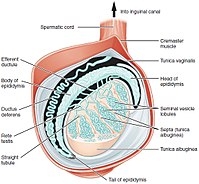
Photo from wikipedia
OBJECTIVES This study evaluated chronological changes in physiological stress and levels of habitual loading of Ibizan populations from the Late Roman-Early Byzantine (LREB) to the Islamic period (300-1,235 AD) using measures… Click to show full abstract
OBJECTIVES This study evaluated chronological changes in physiological stress and levels of habitual loading of Ibizan populations from the Late Roman-Early Byzantine (LREB) to the Islamic period (300-1,235 AD) using measures of body size and bone cross-sectional properties to compare Urban LREB, Urban Medieval Islamic, and Rural Medieval Islamic groups. It also explored the effect of diet, modeled using stable isotopes, on physiological stress levels and behavior. MATERIALS AND METHODS The sample comprised individuals from three archeological populations: Urban Late Roman- Early Byzantine (LREB) (300-700 AD), Medieval Urban Islamic (902-1,235 AD), and Medieval Rural Islamic. Bone lengths, femoral head dimensions, and cross-sectional properties, diaphyseal products and circumferences, were compared to assess differences in body size and habitual loading in 222 adult individuals. Ordinary least squares regression evaluated the correlations between these measures and carbon (δ13 C) and nitrogen (δ15 N) stable isotope ratios in 115 individuals for whom both isotope values and osteological measures are available. RESULTS The Medieval Rural Islamic group had shorter stature and reduced lower limb cross-sectional properties compared to the two urban groups. Limb shape differs between Urban LREB and Urban Medieval Islamic groups. Measures of body size length were positively correlated with δ13 C values in all individuals and separately in the Urban LREB and Rural Medieval Islamic groups. δ15 N showed a positive correlation with left humerus shape in the Urban LREB sample. CONCLUSIONS The low stature and cross-sectional properties of the Medieval Rural Islamic group may be an indicator of greater physiological stress, potentially due to poorer diet. Positive correlations between measures of body size and δ13 C values further suggest that greater access to C4 resources improved diet quality. Alternatively, this relationship could indicate greater body size among migrants from areas where individuals consumed more C4 resources.
Journal Title: American journal of physical anthropology
Year Published: 2020
Link to full text (if available)
Share on Social Media: Sign Up to like & get
recommendations!